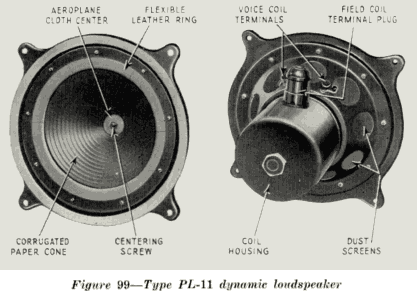149. Stage Loudspeaker. -While all of the loudspeaker units used are of the dynamic type and vary but
little from the construction shown in the diagram, Figure 97, there are slight differences of electrical and
mechanical design.

The stage loudspeaker unit used with the Types PG-1, 2, 3, 4, 6, 7, 8 and 10 Photophone equipments is
the most widely used, and is illustrated in Figure 99 This receives its DC field coil supply from the
Rectox rectifier unit when used with PG-3, 4, 6, 7, 8 and 10 equipments. This is a part of the power
amplifier discussed in section 140. The field coil is nominally rated at 100 volts, although actually the
voltage may be above or below that figure, depending on the source of current. The current used by
this field coil is 0. 1 ampere. In the PG-1 and 2 equipments the fourunit M-G set described in section 36
supplies field current to the loudspeakers.
The PG-13 equipment differs from all others in having a 12-volt field supply for the loudspeaker. This
current is taken from the 12-volt generator, a part of its M-G set, each speaker field coil using 1 ampere.
The speaker unit differs in construction and appearance but very little from the 100-volt field type just
described.
150. Purpose of Monitor Loudspeakers.-A loudspeaker has been installed in each projection room for
the purpose of affording the projectionist a means of following sound cues and to give some idea as to
the continuity of the sound. It should be remembered, however, that due to the noise present in the
projection room, no attempt can be made to judge quality or volume of stage reproduction by means of
the monitor speaker. This should be left entirely to some one in the theatre auditorium and his signals to
the projection room should be depended on in all cases.
4
